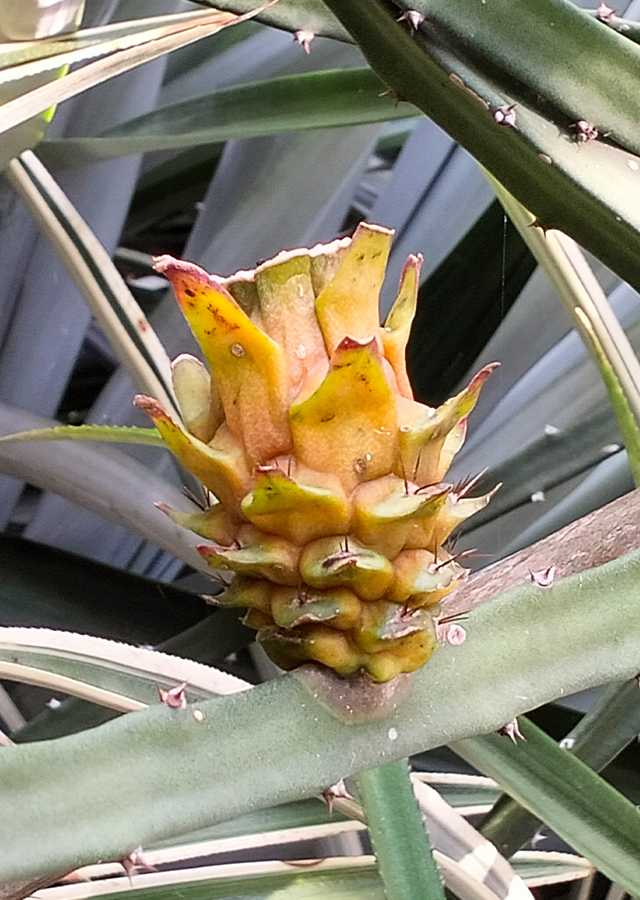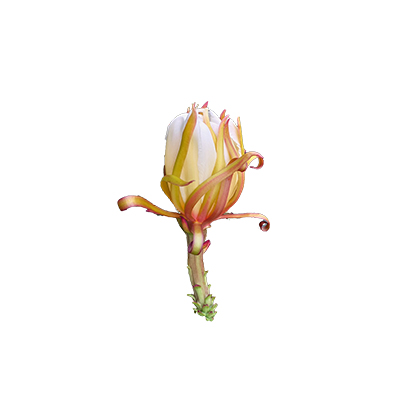Yellow Dragonfruit
Selenicereus megalanthus (K.Schum. ex Vaupel) Moran
Cactaceae
Location in our garden
Orchard



Synonym
Cereus megalanthus K.Schum. ex Vaupel
Hylocereus megalanthus (K.Schum. ex Vaupel) Ralf Bauer
Mediocactus megalanthus (K.Schum. ex Vaupel) Britton & Rose
Habitus
Succulent. An evergreen, epiphytic, succulent climbing shrub growing to 2 m.
Part Used
Seeds
Flowers
Fruit
Growing Requirements
Full Sunshine
Habitat
Forest
Terrestrial
Overview
Selenicereus megalanthus is native and endemic to Latin America (Mexico, Colomcia, Venezuela, Peru and Ecuador). But, as the plant gained popularity due to its benefits, it is now harvested worldwide. The plant is often cultivated fo its edible fruit. Higher in calcium then red dragon fruit. High in antioxidants. High in and dietary fiber. A good source of magnesium, phosphorus, and potassium. Small amounts of iron, vitamin A, Vitamin C, and Niacin. Seeds contain good amounts of omega-3 fatty acids. Flowers are consumed or steeped as tea. The flesh is used to make jellies, jams and marmalades.
Vernacular Names
Gelbe Pitaya (German), Pitaya amarela (Protuguese), Drakonov frukt (Russian), Pitahaya amarilla (Spanish), Gul Pitahaya (Swedish).
Agroecology
Plants can tolerate very high temperatures, and also occasional low temperatures to 0°C. Often an epiphytic plant, though it also grows on the ground. Suitable for: light (sandy), medium (loamy) and heavy (clay) soils, prefers well-drained soil and can grow in nutritionally poor soil. Suitable pH: mildly acid soils and can grow in very acid soils (a pH of 6 or lower). It cannot grow in the shade. It prefers dry or moist soil and can tolerate drought.
Morphology
- Root - fibrous system, yellowish white.
- Stems - green, procumbent, scandent or pendent. It is 1.5 cm thick and produces aerial roots. Margins are undulating, white areoles and yellowish. Several hairs are seen on young growth.
- Flowers - funnel shaped, nocturnal and 32-38 cm long. Pericarpel is ovoid or slightly globose. Tubercles are flattened and large. Inner tepals are 10 cm long and 3.5 cm wide, broader and white. Stamens are numerous which are inserted in two zones and is yellow.
- Fruits - ovoid, spiny, tuberculate with yellow skin. The pulp is white with seeds in it. The pulp has pleasant and mildly sweet flavor.
- Seed - black.
Cultivation
- Generative propagation is by seed.
- Vegetative propagation is by stem cutting.
Chemical Constituents
Fatty acids (palmitic acid, stearic acid, oleic acid, vaccenic acid, linoleic acid, and linolenic acid).
Traditional Medicinal Uses
- It lowers the chances of heart problems and high blood pressure by lowering bad cholesterol levels and replenishes good levels, strengthen immunity, and detoxifies body
- Seeds have antibacterial activity which combat against fungal and bacterial infections and autoimmune diseases in organ systems.
- Its antioxidant helps to maintain overall health and skin health.
- Flowers are used as tea.
Part Used
Reference Sources
- Altuna J.L., Silva M., Álvarez M., Quinteros M.F., Morales D., and Carrillo, W. (2018). YELLOW PITAYA (HYLOCEREUS MEGALANTHUS) FATTY ACIDS COMPOSITION FROM ECUADORIAN AMAZONIA. Asian Journal of Pharmaceutical and Clinical Research, Vol 11(11): 218-221.
- Fern, Ken. (2021). Useful Tropical Plants: Hylocereus megalanthus. http://tropical.theferns.info/viewtropical.php?id=Hylocereus+megalanthus. 14-04-2022.
- Health Benefit Times. (2021). Know about Yellow Dragonfruit. https://www.healthbenefitstimes.com/know-about-yellow-dragonfruit/. 14-04-2022.
- Kew Royal Botanic Gardens. (No date). Plants of the world Online: Selenicereus megalanthus. https://powo.science.kew.org/taxon/urn:lsid:ipni.org:names:232386-2#synonyms. 14-04-2022.
- Plants For A Future. (2021). Hylocereus megalanthus - (K.Schum. Ex Vaupel) Ralf Bauer. https://pfaf.org/user/Plant.aspx?LatinName=Hylocereus+megalanthus. 14-04-2022.


